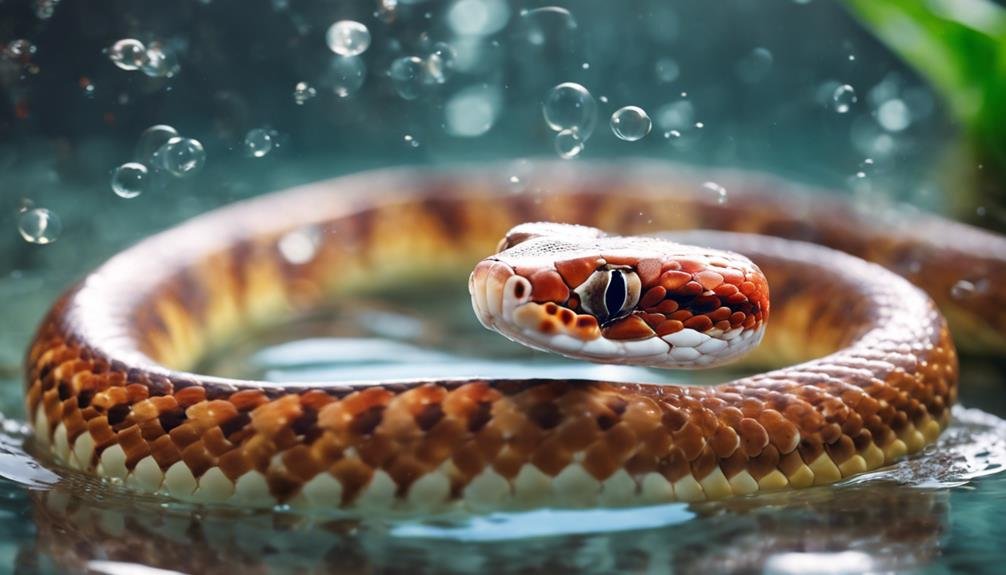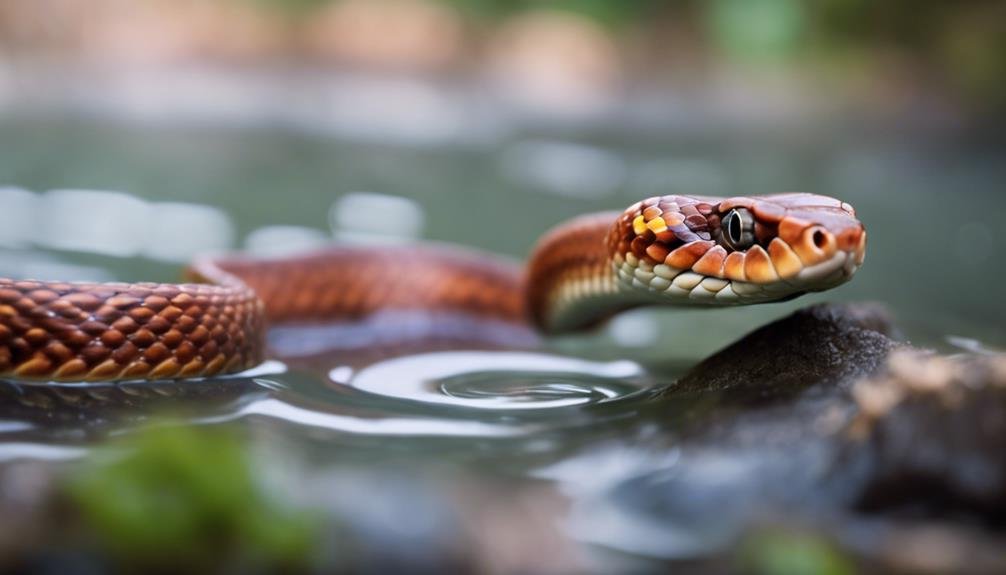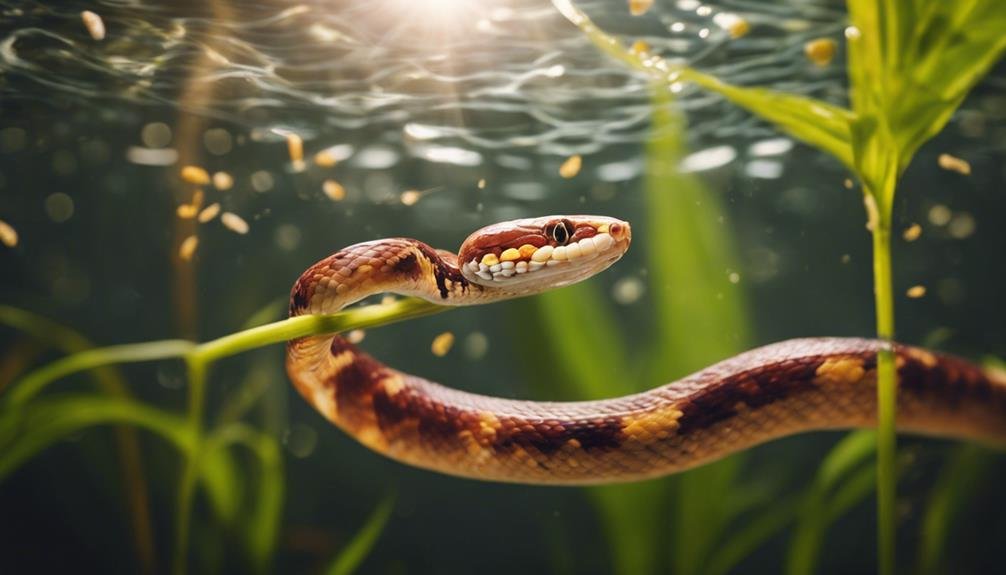You might find yourself pondering whether your corn snake can take to water like a duck or if it's more of a landlubber. Naturally, these slinky reptiles possess an innate ability to swim, a trait that's not just for show but essential for their well-being. From aiding in shedding to ensuring they're properly hydrated, swimming plays a pivotal role in a corn snake's health. However, before you set up a mini-pool in their habitat, understanding the nuances of their aquatic skills and the conditions under which they thrive in water is key. Let's explore what makes these snakes natural swimmers and how you can safely encourage this behavior, leaving behind any misconceptions at the water's edge.
Key Takeaways
- Corn snakes are natural swimmers with inherent aquatic skills vital for their survival.
- They have the ability to hold their breath underwater, aiding in predator evasion and survival.
- Swimming facilitates the shedding process by softening the skin and encouraging hydration.
- Corn snakes prefer soaking in room temperature water, which mimics their natural environment.
- While they can swim, water depth and temperature must be carefully monitored for their safety.
Understanding Corn Snake Behavior
To truly appreciate your corn snake's needs, it's important to understand that these reptiles are natural swimmers who use water for more than just hydration. Corn snakes, from the moment they hatch, have an innate ability to swim. This isn't just for fun; it's an essential part of their survival toolkit. They utilize water for critical activities like shedding and evading predators. While they don't swim for leisure in the same way humans might enjoy a dip in the pool, soaking or bathing can be a pleasurable experience for them, especially when it aids in the shedding process.
Water plays a significant role in keeping their skin moisturized, making it easier to shed the old layer. This is why you'll see your corn snake engaging with water, but always on their terms. They prefer the water to be at room temperature, which is more comfortable for them and mimics their natural habitat.
To support their hydration and facilitate the shedding process, providing a sizable water container with a lid and incorporating hiding spots in their enclosure is essential. This setup not only ensures they're comfortable but also mimics the natural environments where corn snakes thrive.
Natural Swimming Abilities
As you explore the natural swimming abilities of corn snakes, you'll uncover their inherent aquatic skills and how these skills are vital for survival.
You'll also learn about the necessary water safety measures to guarantee their well-being.
Observing their swim behavior can provide insights into their health and stress levels, making it an essential aspect of their care.
Inherent Aquatic Skills
Corn snakes naturally possess the ability to swim from birth, skillfully using water for essential activities like shedding and escaping predators. They're born swimmers, utilizing water not just as a habitat feature but as a crucial tool for survival and health.
While you mightn't catch them swimming laps for fun, they do appreciate a good soak. This isn't just about staying clean; water helps moisturize their skin, making it easier to shed old layers. It's fascinating how these creatures leverage their aquatic skills naturally, without needing lessons or encouragement.
Water Safety Measures
While corn snakes naturally know how to swim, it's important you grasp water safety measures to guarantee their well-being. One vital factor is water temperature. Make sure the water isn't too cold or hot, as extreme temperatures can stress your snake or even cause harm. Ideally, aim for lukewarm water, mimicking their natural environment to make the experience as comfortable as possible.
Additionally, swimming can aid in the shedding process. However, don't force these sessions, especially if your snake seems reluctant. Remember, while they can swim and may enjoy a soak, it's not their go-to activity for fun. Your understanding of their swimming abilities and ensuring a safe, comfortable environment is key to their care and well-being.
Observing Swim Behavior
Understanding water safety measures sets the stage for appreciating how observing a corn snake's natural swimming behavior can offer valuable insights into their overall health and instincts.
From birth, corn snakes exhibit an ability to swim, which isn't just for survival. Swimming aids in their shedding process, making it smoother and less troublesome. Additionally, water acts as a safe haven, offering an escape route from potential predators.
While it's not necessarily for fun, don't be surprised if you find your corn snake enjoying a soak or a bath in water. This behavior isn't just a quirky trait; it's a glimpse into their natural behaviors and instincts. Observing how snakes swim can tell you a lot about their needs and natural habits.
Baby Corn Snakes and Water
You might wonder how best to tend to your baby corn snake's water needs, from bathing to ensuring they stay hydrated.
It's crucial to ponder the depth of water you're offering, ensuring it's safe and comfortable for your young snake.
Let's explore how to properly bathe young corn snakes, the significance of water depth, and their hydration requirements to keep them healthy and stress-free.
Bathing Young Corn Snakes
Many baby corn snakes instinctively know how to swim, but it's important to make sure the water temperature is important to avoid stressing them. These young ones are more sensitive to cold, so getting the bath water temperature right is essential. You shouldn't stress your snakes by soaking them if they're not comfortable. Instead, consider increasing the humidity in their enclosure as an alternative method to keep them hydrated and healthy.
| Factor | Importance | Tips |
|---|---|---|
| Water Temperature | Essential | Ensure it's warm, not hot. |
| Sensitivity | High | Baby corns are more sensitive to cold. |
| Stress | To Avoid | Don't force bathing if it stresses them. |
| Enclosure Humidity | Alternative | Increase it for hydration. |
| Comfort | Key | Monitor for signs of stress. |
Water Depth Safety
When introducing baby corn snakes to water, it's vital to monitor the depth carefully to prevent any risk of drowning. Baby corn snakes are particularly more sensitive to cold water temperatures, making water depth safety a significant concern.
Shallow water levels are your best bet to avoid submersion issues, guaranteeing your little swimmer can safely enjoy the water without the fear of drowning. Including a gradual slope in the water container facilitates safe entry and exit, supporting their exploration without mishaps.
It's important to provide a controlled environment where baby corn snakes can safely engage with water, emphasizing their well-being. Keeping these precautions in mind will ensure your baby corn snake can swim and explore water safely, highlighting the importance of water depth safety in their care.
Hydration Needs Explained
Understanding your baby corn snake's hydration needs is crucial for their health and well-being. It's essential to know that they're more sensitive to cold, so warm water is key for their comfort during hydration. However, don't stress them with excessive soaking, as it's harmful. Make sure the water temperature is just right to avoid health issues. If they're not keen on water, increasing humidity is a good alternative.
| Factor | Importance |
|---|---|
| Warm water | Prevents stress |
| Sensitivity to cold | Requires careful temp control |
| Excessive soaking | Avoid to prevent harm |
| Proper water temperature | Essential for health |
| Alternative hydration method | Increase enclosure humidity |
The Soaking Habit Explained
To guarantee a successful shedding process, corn snakes often engage in soaking, a natural behavior that softens their skin and facilitates the removal of old layers. This soaking isn't just a pivotal part of their health regimen; it's a critical aspect. By immersing themselves in water, they make certain that their skin is moist enough to shed properly, preventing any shedding complications that could arise from dry or unhealthy skin.
Providing a water container that mimics their natural environment not only encourages this soaking behavior but also plays a significant role in their overall hydration and skin health. It's essential for you, as a corn snake owner, to comprehend the importance of this process. Proper moisture levels are crucial for a smooth shedding cycle, and by ensuring your pet has access to a suitable soaking spot, you're directly contributing to their well-being.
Breath Holding Capabilities


After exploring how soaking is essential for a corn snake's shedding process, let's now examine their impressive ability to hold their breath underwater for extended periods. You might find it fascinating that corn snakes can stay submerged for up to an hour. This might seem like a stretch, but some sources even suggest a limit of about 50 minutes. It's not just about the time they spend underwater; their swimming capabilities are remarkable too.
| Factor Influencing Breath Holding | Detail |
|---|---|
| Activity Level | Lower activity means longer underwater time |
| Metabolism | A slower metabolism extends breath-holding |
| Swimming Speed | They're notably faster in water |
| Individual Variation | Swim abilities vary among snakes |
These factors play a significant role in how long your corn snake can swim and stay submerged. It's intriguing to note that their speed in water outpaces their land mobility. This enhanced speed, combined with their ability to hold their breath for minutes on end, underlines the adaptability and resilience of corn snakes in aquatic environments. So, whether it's for hydration, shedding, or simply a swim, your corn snake's underwater escapades are both a necessity and a spectacle.
Step-by-Step Bathing Guide
First, you'll need to fill a shallow container with room temperature water, ensuring it's deep enough for your corn snake to soak but shallow enough for it to lift its head above water. This balance is important because while snakes can swim, the right temperature for a corn snake during bathing is vital to their comfort and safety.
Once you've got the setup right, gently place your corn snake into the water. It's important to monitor it closely throughout the soaking session to prevent any potential issues from arising. Typically, a soak should last between 10 to 20 minutes, which gives your snake ample time to get hydrated and might even help if it's been having trouble shedding.
During the soak, you can gently massage your snake. This isn't just a bonding moment; it's also practical. Massaging can help stimulate bowel movements, especially if your snake has been experiencing any digestive issues.
Water Temperature and Safety


Ensuring your corn snake's bath water is at room temperature is essential for their safety and comfort while swimming. When snakes swim, the water temperature plays a pivotal role in their overall well-being. It's not just about making sure they can paddle around; it's about keeping their environment as important as possible. Extreme temperature changes, whether too hot or too cold, can harm your corn snake by causing unnecessary stress or even health issues.
Maintaining a stable water temperature that mimics their natural habitat is vital. This consistency helps in preventing the shock that could come from sudden changes, ensuring your slithery friend feels secure and at ease. Remember, the goal is to recreate a setting they'd encounter in the wild, where drastic swings in temperature are rare.
Do Corn Snakes and Crested Geckos have similar swimming abilities?
Yes, corn snakes and crested geckos both have similar swimming abilities. Despite being primarily terrestrial animals, both species are capable of swimming if necessary. However, it’s important to note that while they can swim, they are not particularly adept at it and may struggle in water for extended periods. Overall, crested geckos swimming ability is limited compared to more aquatic reptiles.
Shedding and Water Needs
During the shedding process, your corn snake will need extra water to help moisturize its skin and prevent any complications. This is important because water plays a significant role in ensuring the skin is supple enough to shed completely. Dry skin can lead to bits of old skin sticking uncomfortably to your snake, which might cause stress or even injury as it tries to remove the remnants. Providing adequate moisture through their environment and water bowl is key to a successful shedding.
Water aids in loosening the old skin, making it easier for your corn snake to slither out of it comfortably. Imagine it as a natural lubricant that facilitates the smooth removal of the old layer. This is why keeping an eye on your corn snake's water needs, especially during the shedding period, is essential. It's not just about quenching their thirst; it's about ensuring their overall well-being during what can be a taxing process for them.
Conclusion
To sum up, you've seen that corn snakes are natural swimmers who thrive in water. Whether it's aiding in shedding or simply enjoying a soak, your corn snake benefits greatly from safe, shallow water baths.
Remember to keep the water at room temperature and always supervise their aquatic adventures. By understanding their breath-holding capabilities and following a simple bathing guide, you're ensuring your snake's health and happiness.
So, don't hesitate to let your slithery friend enjoy a swim—it's in their nature!



[…] can corn snakes swim. While they are not natural swimmers, they are capable of swimming when necessary, typically to […]